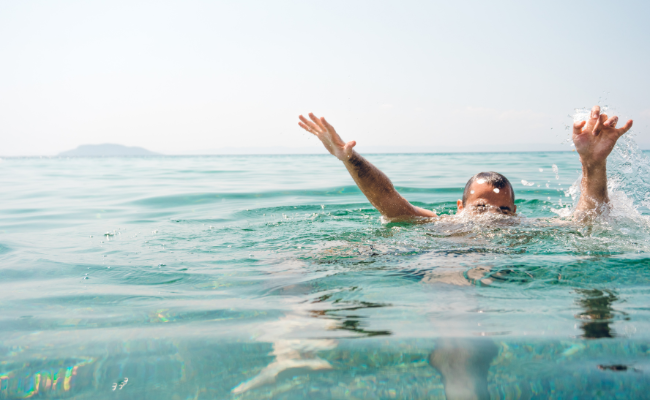What to do incase of First Aid For Drowning?
- November 30, 2023
- No Comments

What is Drowning?
Drowning, constituting a life-threatening emergency, transpires when an individual undergoes respiratory impairment resulting from submersion or immersion in liquid. This urgent scenario necessitates prompt and efficient intervention to avert irreversible damage or the loss of life, underscoring the critical importance of knowing how to respond swiftly during a drowning incident where every second is crucial. The outcomes of drowning can be classified into three primary groups: death, morbidity, and no morbidity.
Why Drowning occurs?
The urgency in responding to a drowning incident lies in the rapid onset of hypoxia, or lack of oxygen. Drowning can happen silently, without the usual loud splashing or calls for help, making it even more challenging to detect. In just a few minutes, lack of oxygen can lead to brain damage, emphasizing the crucial need for immediate and appropriate first aid. Recognizing the severity of drowning and the potential consequences underscores the importance of swift action.
How to manaage drowning:
- Assess the Situation: Before attempting any rescue, ensure your safety. If it's safe, quickly assess the situation and call for professional help immediately.Determine the need for a water rescue and avoid entering the water unless trained. Reach or throw a buoyant device to the person in distress, maintaining a safe distance.
- Reach or Throw, Don't Go: Extending a reaching object, throwing a buoyant device, or utilizing any available means to provide assistance without entering the water is crucial.Entering the water without proper training can escalate the situation and put both the victim and the rescuer at risk.
- Pull, Don't Lift: If the person is within reach, pull them to safety using a horizontal pull to minimize strain on the spine.Avoid lifting the person vertically, as this could exacerbate potential spinal injuries.
- Check for Breathing: Once on dry land, check for breathing. If the person is not breathing or breathing irregularly, initiate CPR immediately.If CPR is unfamiliar, provide hands-only CPR (chest compressions without rescue breaths) until professional help arrives.
- Call for Help: Even if the person seems to recover, seek medical assistance promptly. Secondary drowning, where fluid enters the lungs and causes breathing difficulties later, is a risk that requires medical evaluation.
- Call emergency services and follow their instructions while awaiting professional help.
- Monitor Vital Signs: Keep a close eye on the person's pulse and breathing until medical professionals take over.Be prepared to continue CPR if necessary and follow any instructions provided by emergency services.
Treatment Solution:
- CPR Training: Acquiring CPR training is a fundamental and effective way to be prepared for a drowning emergency.Basic CPR skills empower individuals to provide initial aid until professional help arrives, significantly impacting the chances of survival.
- Water Safety Education: Prevention is key, and educating oneself and others on water safety practices is paramount.Understanding the importance of lifeguards, swimming lessons, and the buddy system can help avoid drowning incidents.
- Emergency Response Plan: Establishing an emergency response plan for water-related activities is crucial for swift and coordinated action.Designate individuals trained in CPR and familiar with the location's emergency procedures to ensure a quick and effective response.
- Safety Equipment: Always have safety equipment, such as life jackets, lifebuoys, and reaching poles, readily available near water sources.These tools facilitate a quick response without putting additional people at risk and can be essential in rescue efforts.
- Supervision: Active supervision is essential, especially when children are around water.Drowning incidents often occur quickly and silently, making constant vigilance crucial in preventing accidents.
Benefit Points:
- Increased Survival Rates: Immediate and appropriate first aid significantly increases the chances of survival for drowning victims.Quick intervention can prevent irreversible damage and improve overall outcomes.
- Reduced Risk of Secondary Drowning: Timely medical attention can help identify and address potential complications, such as secondary drowning.This reduces the risk of delayed respiratory distress, providing a more comprehensive approach to post-drowning care.
- Community Preparedness: Training communities in basic first aid and CPR enhances overall preparedness for emergencies.This collective knowledge can save lives and create a safer environment for everyone, fostering a sense of community responsibility.
- Prevention Through Education: By promoting water safety education, individuals become more aware of potential risks, leading to proactive measures to prevent drowning incidents.Education acts as a powerful tool in creating a culture of safety and responsibility around water-related activities.
- Confidence in Emergency Situations: Acquiring first aid skills instills confidence in individuals facing emergency situations.Knowing how to respond appropriately can make a crucial difference and potentially save lives, contributing to a more resilient and prepared community.
Comments (0)